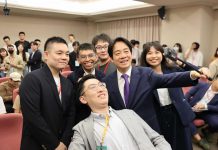This is also true for 17-year-old Kinson Chan, a Year 13 IB student studying in Sha Tin College. Chan says the international school system does not teach enough about local issues. His only school contact with local affairs and communities came through his CAS Project. For this, he chose to teach English to students at a local secondary school. He visited the school once a week for two to three months.
Chan says he did interact with more local students for the project, but this only had a short-term effect. “We take it, like, for fun. We do activities, we play around with the students,” he explains. It may have provided him with an experience, but Chan says it did not really deepen his understanding of local affairs.
Apart from his limited knowledge of local affairs, Chan is also worried about his Chinese proficiency. He is currently studying the lowest level of Chinese in his school’s curriculum. Although he has no problem speaking Cantonese, his written Chinese is a problem. “I speak [Cantonese] at home, so it’s not bad,” he explains. “But for writing, I sort of lack writing skills because, you know, I don’t write much in Chinese.”

While he is concerned, his parents do not seem to be worried. It was they who enrolled him in an international school because they wanted him to excel at English and think that “English is more important than Chinese,” says Chan.
In the past, the local education system resembled the British education system. However, after the handover, it went through drastic changes. The primary curriculum includes a range of subjects including social studies, science, Chinese, English, mathematics, music, arts, and physical education. For secondary education, students are required to take core subjects – English, mathematics, Chinese, and liberal studies – and will choose two or three elective subjects.
While local schools prepare their students for the Hong Kong Diploma of Secondary Education Examination (HKDSE), international schools offer a broader range of study plans such as the IB programme, or curricula from the United States or United Kingdom, in which case students may take SAT exams, Advanced Placement (AP) tests, or the General Certificate of Secondary Education (GCSE) exams. Over 3,300 tertiary institutions in nearly 90 countries currently recognise the IB programme, whereas 250 tertiary institutions recognise the HKDSE programme.
This is one of the reasons an increasing number of local parents choose to send their children to international schools. According to the 2015 annual report published by the ESF, almost 70 per cent of the students’ parents are permanent residents of Hong Kong. Chinese is the largest ethnic group in ESF schools, constituting 46 per cent of all students.
Salamanca Ha Suk-man is a mother of three. She says she sent all three of her children to international schools because she says they offer more all-round development, with less emphasis on drills, and rote-learning.
“Traditional schools are very intense and everything is about examination,” Ha says. “But international schools offer more opportunities and they won’t pressure students in the early stages.”
She thinks that local schools restrict students’ development by overlooking the importance of less academic areas such as music, sports or art.
“When exams are coming up and there is not enough class time, the first class to be cancelled will be PE. Then it will be art,” said Ha. “They put too much emphasis on the development of knowledge and intelligence, rather than an all-round development, which is my concern.”






































